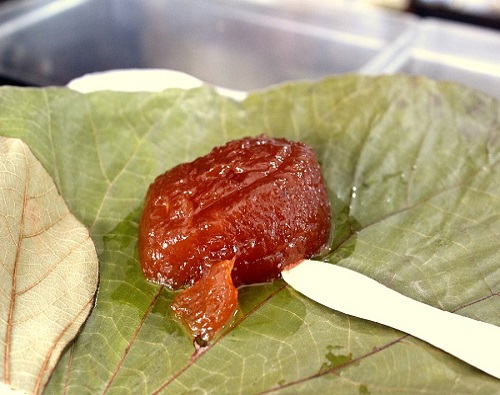In thoonga nagaram, or the city that never sleeps, culinary influences have been adopted to create dishes that are even better than the original, including the Tirunelveli halwa.
This article was published in The Goya Journal on 17, May 2019
When one thinks of Madurai, sugar-laden delicacies is not necessarily first thing that comes to mind. This ancient city on the Vaigai river in Tamil Nadu is synonymous with the breathtaking Meenakshi Amman Temple. But Madurai received worldwide attention even before this place of reverence and its architectural splendour came to be. In 302 BC, Megasthenes the Greek diplomat and historian, visited the city of Madurai, an important trade centre back then, and described its beauty in his writings.
Draw a map of Madurai’s culinary history, and it will lead you to an important era in the history of Tamil literature, the Sangam period. This period between 300 BC and 300 AD is marked by several poems which laud the kings, praise their bravery and give us all a glimpse into lives back then under the Chera, Pandya and Chola dynasties.
In the acclaimed poem about Madurai, Maduraikanchi, the poet Mangudi Maruthanar praises the Pandya king Nedunjeliyan II for his victories and describes the opulence of the period with examples of food distributed to its citizens. This poem references ‘juicy, fragrant jackfruit flesh’, and ‘sweet rock sugar that tastes like nectar,’ even a dish that we now know as biryani (‘popular dish of big meat chunks cooked with rice’).
Today, Madurai’s food culture is an amalgamation of its many neighbouring influences, says Sahithya Academy Award-winning writer and novelist, Nanjil Nadan. He explains that with places like Virudhunagar, located about 53 kilometres south of Madurai famous for sattur karasev (a snack made with chickpea flour, rice flour and spices, mixed into a dough that is passed through a sieve and then fried in hot oil), and Virudhunagar’s fried parotta, to Kovilpatti’s famous peanut candy or kadalai mittai, and Dindigul with its trademark biryani, Madurai has strong culinary trailblazers all around. The biggest influence of all of these, of course, comes from the kitchens of the Chettinad region. The Chettinad mess is a familiar spectacle in Madurai.
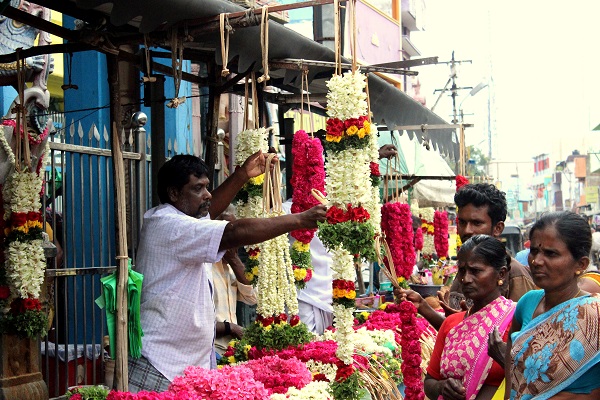
In The Penguin Food Guide To India, Charmaine O’ Brien writes evocatively about the culinary heritage of Madurai. Her recommendations for eating out in the city includes lunch at Modern Restaurant, idlis at the Murugan Idli Shop, coffee at Sri Sabaree’s and halwa at the shop where I stood, camera in hand, on a hot Thursday morning — Prema Vilas.
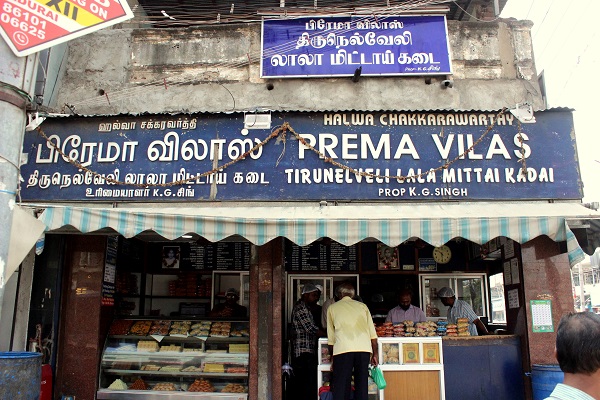
Established in 1954, Prema Vilas is the perfect example of Madurai imbibing a culinary tradition as its own, and creating a product as good as (some argue, even better) than the original. On the blue board beneath the name of the shop is a nod to the origins of the sweets made here — ‘Tirunelveli Lala Mithai Kadai’.
It is a well known fact that the Tirunelveli halwa is a serendipitous by-product of the Zamindari System. S. Ganga Ram Singh, third generation family member who runs Prema Vilas today along with his cousins, tells us that his grandfather, the first Ganga Ram Singh and founder of this sweet shop, originally belonged to Uttar Pradesh. He was one of the personal bodyguards to the zamindars in Tirunelveli. After the Zamindari System was abolished, Ganga Ram Singh’s grandmother, Lakshmi Bai, suggested they open a sweet shop. The family relocated to Madurai and set up Prema Vilas. The sweet shop is named after Ganga’s first daughter, Prema Bai.
For its iconic status, Prema Vilas is humility in structure and function.The store has just enough place for employees to quickly spoon halwas out onto mandharai leaves and hand them across the counter to crowds of customers who stop by for their sugar fix. A popular way to eat this is to chase each mouthful of halwa with a spoonful of spicy mixture, which provides a delightful contrast in flavour and texture.
Nageshwaran who has been working with the family since 1998 proudly tells me that their sweets are most sought after for weddings and festivals. Prema Vilas sweets are often shipped abroad by parents who want to send their newly-wed daughters a small reminder of home, he says with pride.
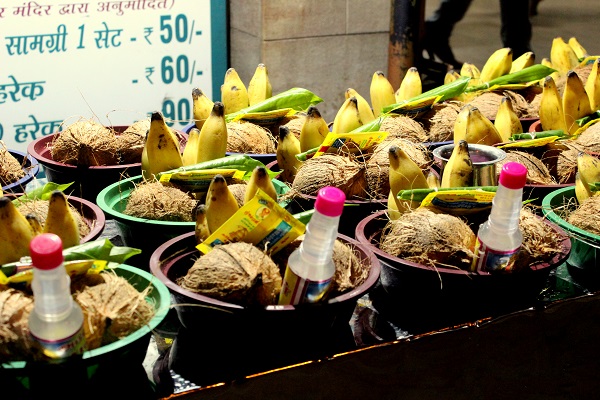
About 2 kilometres from the shop is a small factory where the sweets are prepared. Walk in and you will find yourself caught in heady fragrances of sugar, ghee, where an assortment of sweets are being fried, swished around in sugar syrup or left to cool. Udaya Kumar, who supervises the production, says that days start as early as 7:00 a.m. and goes on till 2-3 p.m. But during festivals, especially Diwali, production shoots up, and sweet making goes on till as late as 9:30 pm.
In one corner of the factory, two employees deftly mix muscoth halwa, a thick gooey sweet mixture, in a large pan over an earthen stove. It is made of wheat milk, coconut milk, coconut oil and of course, sugar. It will soon be transferred into pans, and left overnight to cool and set.
In another corner, two ladies roll out laddoos, a large plate of sweetened boondi (chickpea flour passed through a sieve, fried and soaked in sugar water) between them. Large orders for these laddoos are often part of the wedding offering in these areas. Besides laddoo, and muscoth halwa, milk halwa, carrot halwa, badam halwa, badusha, rava laddoo and savouries like mixture, pepper sev are also made here.
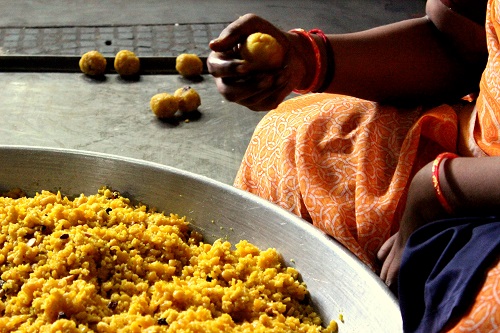
People talk in years in these corners. Their sweets are art perfected over time. I wondered if that was the secret of Prema Vilas. But I quickly realised that it is hard to decode the place through a resume like approach. This is so much more than number of years of experience.
S Mukundan who is a resident of Madurai, and conducts food tours there says this is about authenticity. “Prema Vilas is special because the halwa that you get there is similar to what you get in Tirunelveli. When I say Tirunelveli, halwa is the first thing that comes to your mind. Prema Vilas is able to give you that experience in Madurai. It is a family run enterprise which adds to this authenticity.“
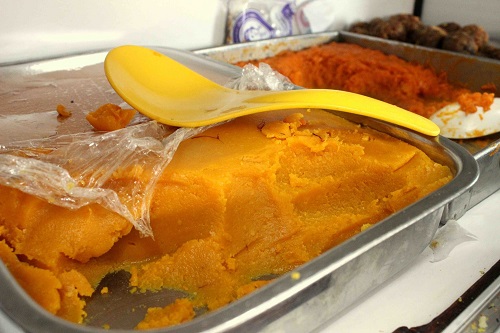
Nanjil Nadan says that the secret to the popularity of Prema Vilas halwa is making sure that that they protect the recipes that have been handed down over generations. The fact that they do this without compromising on quality, or making the product less affordable is commendable, he adds. I realised that this fact, in a nutshell, is the city itself.
“Madurai is the epicentre for many of the nearby towns. People come here for various reasons — to make purchases, to visit the temples. So the city never sleeps, and it is called thoonga nagaram. No matter what time you show up, Madurai will have warm food waiting for you. And it’s not just any food, its delicious food, cooked with the right ingredients, made the right way, and most importantly, served the right way,” adds Nanjil Nadan.
Mukundan adds to this and says the whole mess culture evolved in this city. Home cooked meals were brought to the streets to give people working away from home, a suitable option. “Madurai is one of the oldest cities, and what’s great about it is some of the old food traditions are still around. Its because the people here support these local establishments. For example, The Famous Jigarthanda store has been around since 1977, and recently they have expanded their brand. That is an example of a single product, that is all they sell, it is authentic, and they make it great.”
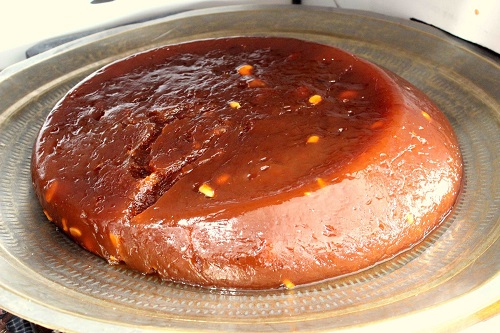
Madurai’s strength lies not just in its signature creations, but also in adopting food influences and setting the benchmark for them, piping hot halwa included. The city has perfected the art of adopting one dish and making it exceptionally well, whether it is the idlis at Murugan Idli Shop or iddiyappams at Burma Idiyapam Shop or halwa at Prema Vilas.
I was back at Prema Vilas to get a taste of their famous wheat halwa. The first spoonful of this rich sweet, and it slid off my tongue, leaving a medley of flavours in its wake. There was sugar and ghee of course, but there was something else there. Closing my eyes, I was transported to a wedding, seated in front of a banana leaf, or to the living room of an old aunt’s home. I tasted familiarity and the richness of authenticity. The city that never sleeps was buzzing around me, and in that moment, its love affair with food became all too clear.
This article was edited by The Goya Journal.
Kindly credit The Yellow Turmeric for the images, if you are republishing this article.
You May Also Like:
An Indian chef is giving Las Vegas a taste of Kerala’s toddy shop food
